
H.E.S.S. Physics Working Group on Multiwavelength Observations
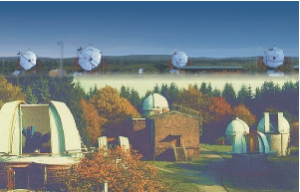

|
H.E.S.S. Physics Working Group on Multiwavelength Observations |

|
|||||||||||||||||||||||||||||||||||||||||||||||||||||||||||||||||||||||||||||||||||||||||||||||||||

The H.E.S.S. Array with its five Cherenkov telescopes and auxiliary optical telescopes in the foreground.
The H.E.S.S. Experiment was built to explore the Very High Energy (VHE, E > 0.1 TeV) sky in the Southern hemisphere. It is named in honor of Victor Hess who discovered Cosmic Rays in 1912. A chief goal of the experiment is the identification of the accelerators of Cosmic Rays. With the spatially resolved images of shell-type supernova remnants at photon energies up to 100 TeV and the unambiguous association of extragalactic sources of TeV radiation with variable AGN, different classes of accelerators have been identified.
Astrophysical observations at the highest energies probe the non-thermal universe in many different environments. Non-thermal relativistic plasma radiates throughout a very wide energy range via synchrotron emission and Compton scattering. Multi-frequency observations are crucial to probe magnetic and radiation fields and thus enable the reconstruction of the energy spectra of the underlying particle distributions. Likewise, the generation of gamma-ray emission from interactions of Cosmic Rays with dense interstellar matter connects probes provided by gamma-ray and multi-frequency observations.
Multi-frequency studies are also essential for many other reasons. The pioneering observations by the H.E.S.S. collaboration resulted in the discovery of many objects, in particular in the Galactic plane. An identification of newly detected sources, especially those that had hitherto been unnoticed in other wavelength regimes, is a first step towards physical characterization. Multi-band cross-identifications also help in deblending crowded regions, which are subject to superposition of several, frequently extended sources.
The H.E.S.S. Collaboration cooperates with many individuals, teams, and consortia in the joint endeavor of determining the properties of the astrophysical sources of the most highly energetic radiation. Examples of such cooperations are shown below.

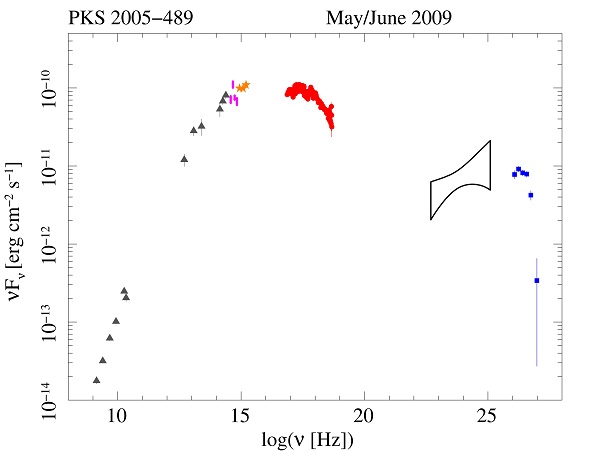
(left) The Vela SNR region in the soft and hard X-ray bands and in VHE g-rays. The PWN Vela-X and the shell-type SNR RX J0852.0-4622 display matching morphologies.
(right) Spectral energy distribution of the Blazar PKS 2005-489 from simultaneous observations in the entire electromagnetic spectrum during a bright outburst in the synchrotron domain.

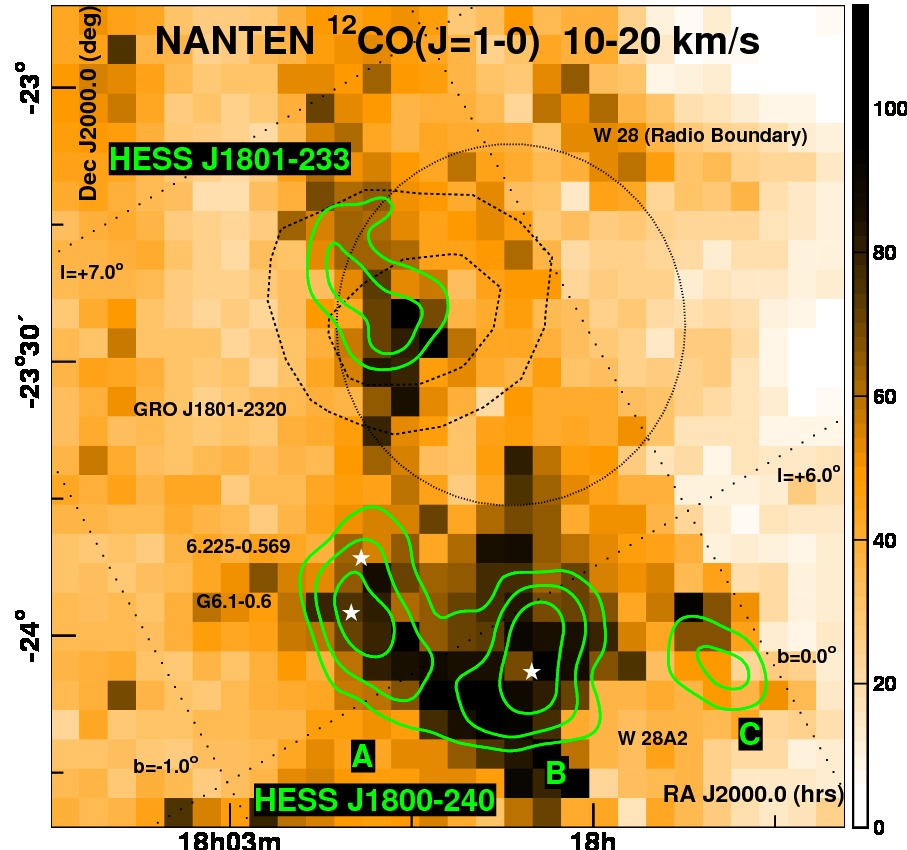
(left) Contemporaneous monitoring of the AGN PKS 2155-304 in different wavebands reveal a complex broad-band variability pattern with corresponding TeV (top) and optical (bottom) lightcurves.
(right) Spatial association of the g-ray sources HESS J1800-240 and HESS J1801-233 with molecular gas. Interactions of freshly accelerated Cosmic Rays with dense ISM is considered to be the origin of the hadronic gamma-ray emission.
H.E.S.S. is an experimental facility for very high energy gamma-ray astrophysics and particle-astrophysics. It is operated by the H.E.S.S. collaboration (170 scientists from 32 institutions in 12 countries). The experiment is set up in the Khomas Highland in Namibia (23 16' 18Â S, 16 30' 00Â E) at 1800 m altitude.
Phase I consists of four identical telescopes with a mirror collection area of 108 square meter each, arranged in a square of 120 m, yielding a collection area for gamma-ray showers of about 100.000 square meters. It started full operation in January 2004.
The cameras use 960 PMTs each and image a field of about five degrees. The H.E.S.S. I array provides data above 100 GeV with an energy resolution of about 15% and an angular resolution of 0.1 degrees. Provided sufficient statistics, an astrometric precision of 8Â can be reached.
In 2012 a fifth telescope started operations (see below).
H.E.S.S. has detected 70 Galactic and extragalactic sources of VHE emission of many different source classes, including stellar sources in external galaxies, and distant AGN. The measurements are used to study the specific sources and a range of different phenomena, including cosmological evolution of the extragalactic background radiation and intergalactic magnetic fields, Dark Matter, Lorenz Invariance, charged Cosmic Rays and heavy ions, the diffuse interstellar medium and Cosmic Ray propagation.
The collaboration published more than 110 articles in refereed journals and was awarded the Descartes Prize of the European Commission in 2006 and the Rossi Prize of the American Astronomical Society in 2010. In 2006 it was ranked among the 10 most influential observatories worldwide.
The H.E.S.S. Collaboration maintains a Gamma-Ray Burst (GRB) program, fed by the GCN network. A ROTSE telescope is operated on-site. More than 30 triggers for fast follow-up observations have led to observations with the H.E.S.S. Array.
The collaboration operates a dedicated robotic 80 cm optical telescope (ATOM) on site. Simultaneous optical observations are conducted for any multifrequency campaign with H.E.S.S. participation.
The collaboration cooperates with other teams on multifrequency projects (e.g. data mining of proprietary data sets and surveys), alerts (e.g. TOO programs) and common observing programs for variable sources.
TOO programs for different observatories and satellite facilities in radio, radio interferometric strudies, mm and sub-mm bands, optical, X-ray and lower energy gamma-ray bands are pursued.
Identification of new detections and detailed characterization of sources detected with H.E.S.S. are conducted through observing programs at other facilities, including MOPRA, GCMT, ATCA, HRT, NRT, VLA, JCMT, VLBA, VLBI, Spitzer, CAHA, ESO, SSO, Swift, RXTE, XMM-Newton, Chandra, Suzaku, Integral, AGILE, and Fermi.
The collaboration participates in coordinated multifrequency campaigns on variable sources (e.g. Sgr A*, M 87, Blazars).
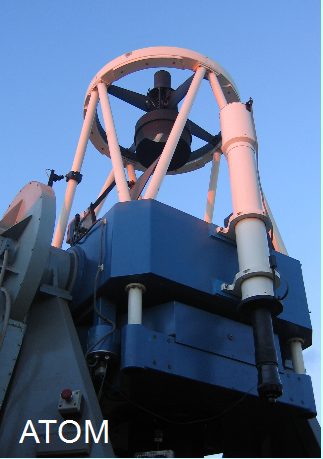
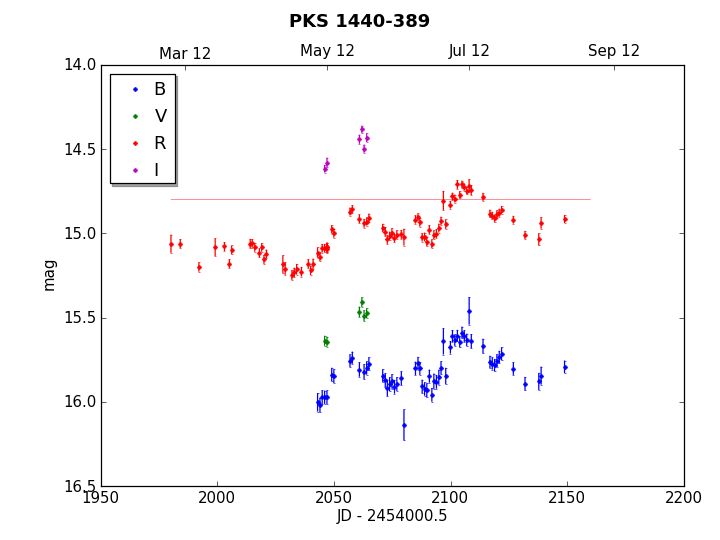
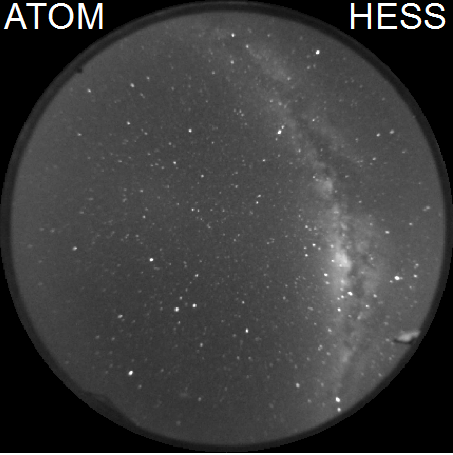
(left) The Automatic Telescope for Optical Monitoring (ATOM) is operated by the H.E.S.S. Collaboration on the H.E.S.S. site in Namibia to monitor the atmospheric transparency via all-sky extinction measurements (right), to obtain simultaneous optical photometry of potentially variable sources observed with the H.E.S.S. array, and to monitor about 200 compact astronomical gamma-ray sources, providing triggers (middle). Observations are conducted and analysed in a fully robotic mode.

With more than 50 sources and widely distributed diffuse emission, the H.E.S.S. Galactic Plane Survey provides multifrequency insights and challenges. From identification of objects first seen at TeV energies, to associations with known objects and decompositions of blended complexes to broadband characterization and modelling of emission processes, multifrequency studies are a crucial aspect for the H.E.S.S. physics programme.
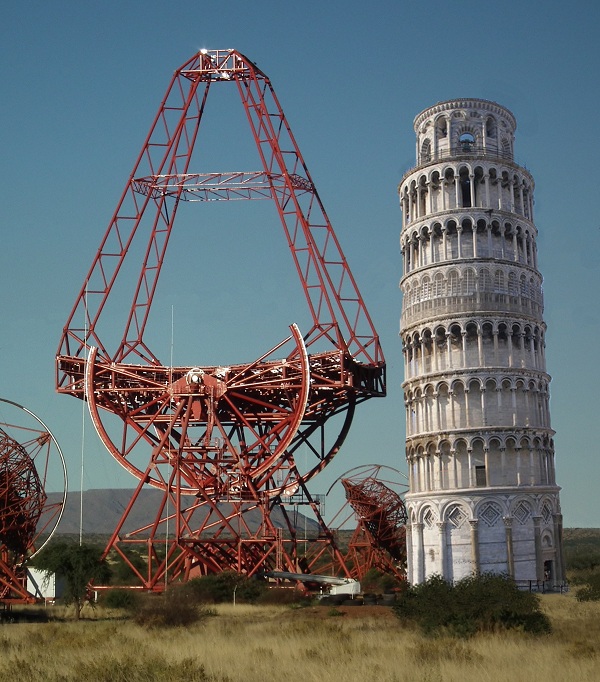 Starting 2012 the original H.E.S.S. array is complemented by a new telescope with a main mirror area of 600 square meters. The telescope can be used stand-alone in mono-mode or in conjunction with the original array in hybrid mode. The latter provides a significantly improved sensitivity in the energy range up to about 1 TeV. The large collection area will allow studies of gamma-rays in the energy range above 40 GeV and will bridge the gap to satellite-based gamma-ray astrophysics. The most noticable consequence will be the ability to probe gamma-rays out to the opacity horizon set by the diffuse extragalactic background-light at all energies. H.E.S.S. II with its very large collection area will be used to explore variable sources, such as GRBs, jets, pulsars and supermassive and stellar-mass Black Holes.
Starting 2012 the original H.E.S.S. array is complemented by a new telescope with a main mirror area of 600 square meters. The telescope can be used stand-alone in mono-mode or in conjunction with the original array in hybrid mode. The latter provides a significantly improved sensitivity in the energy range up to about 1 TeV. The large collection area will allow studies of gamma-rays in the energy range above 40 GeV and will bridge the gap to satellite-based gamma-ray astrophysics. The most noticable consequence will be the ability to probe gamma-rays out to the opacity horizon set by the diffuse extragalactic background-light at all energies. H.E.S.S. II with its very large collection area will be used to explore variable sources, such as GRBs, jets, pulsars and supermassive and stellar-mass Black Holes.
The H.E.S.S. collaboration has formed a Multiwavelength Working Group, consisting of collaboration members. Please check for the member list and contact information here:
Information on workshops and meetings organized by the multiwavelength working group can be found here:
Information on H.E.S.S. observations of gamma-ray bursts can be found here:
These pages are only accessible for H.E.S.S. members (using the H.E.S.S. login).
The pages are password protected, please use the campaign login which is distributed among the observers. H.E.S.S. collaboration members can use the usual H.E.S.S. login, too.
This page is provided by the HESS group of the Landessternwarte Heidelberg.

The page is mainained by
Gerd Pühlhofer.
Last update of this page on April 30, 2018